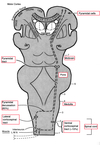Nervous system: Motor systems Flashcards
(39 cards)
What is the function of the pre central gyrus?
It is the primary motor cortex and control nerve stimulation for muscle movement
Where does the information from the primary motor cortex go?
It goes down the spinal cord to another neuron (FYI this neuron then takes the info to specific muscles)
What are the cell-bodies in the primary motor cortex called?
Pyramidal cells
What are some properties of pyramidal cells?
They are very large, they look like triangular cells with a prominent axon off them and are heavily myelinated
How long are pyramidal cells?
Up to a meter + long
Why are pyramidal cells very large?
They have to drive neural signals over a very large distance
What kind of representation is on the primary motor cortex?
A homunculus representation
If our motor planning area was damaged, what specific areas would be impacted? How would this affect our ability to move?
Broca’s, Frontal eye filed and Exners area’s
We would have only very coarse movements
What about pyramidal cells makes them good at transmitting neural information over long distances?
They are very large so can generate a large current
They are heavily myelinated so that the charge is not lost over the distance
On this diagram you can see that there is a large bulge in the middle, what is this called? Why is there this large bulge?

Pons
It is because this is where the cranial nerves, neves that go to the face, exit and there are lots of nerves and cell-bodies involved in this therefore lots of space necessary
What does corticospinal mean?
It means that the nerves go from the cortex to the spinal cord
Where does most of the desiccation of the corticospinal tract occur?
In the pyramid of lower medulla oblongata
What is the medulla oblongata?
Region of nerual tissue in the brain stem that control autonomic functions
How much of the pyramidal cells decussate at the lower medulla oblongata?
~85%
Where does the pyramidal tract that decussates at the medulla go down?
Goes down into the lateral corticospinal tract in the spinal cord
What does the pyramidal tract that did no decussate at the medulla go down?
Goes down the ventral corticospinal tract
Where does the pyramidal tract that goes down the ventral corticospinal tract decussate?
In the spinal segmental level
Label the diagram


What is the difference between and upper motor neutron and a lower motor neuron?
An upper motor neurone (i.e. pyramidal cell) is in the cortex while a lower motor neurons are in the spinal segmental level
How are lower motor neurons utilised in transmitting motor information? How do these signal then get transmitted to the body?
1 - Information from the upper motor neurons travels down the pyramidal tract
2 - ~85% of these decussate and go down the lateral corticospinal tract to the spinal segmental level needed
3 - Once in the spinal segmental level it this synapses across to the lower motor neuron in the spinal cord
4 - From the lower motor neurons it goes out the ventral root to the muscles
What are cranial nerves?
Nerves that control facial muscles
From the Primary motor cortex, where do the cranial nerves go?
They go down the pyramidal tract but deviate off at the pons (don’t go down spinal cord)
What do the ventral cotricospinal tract nerves generally control?
The core muscles (i.e. back, core…)
What do the lateral corticospinal tract nerves generally control?
The peripheral muscles (i.e. arms, hands, legs…)






